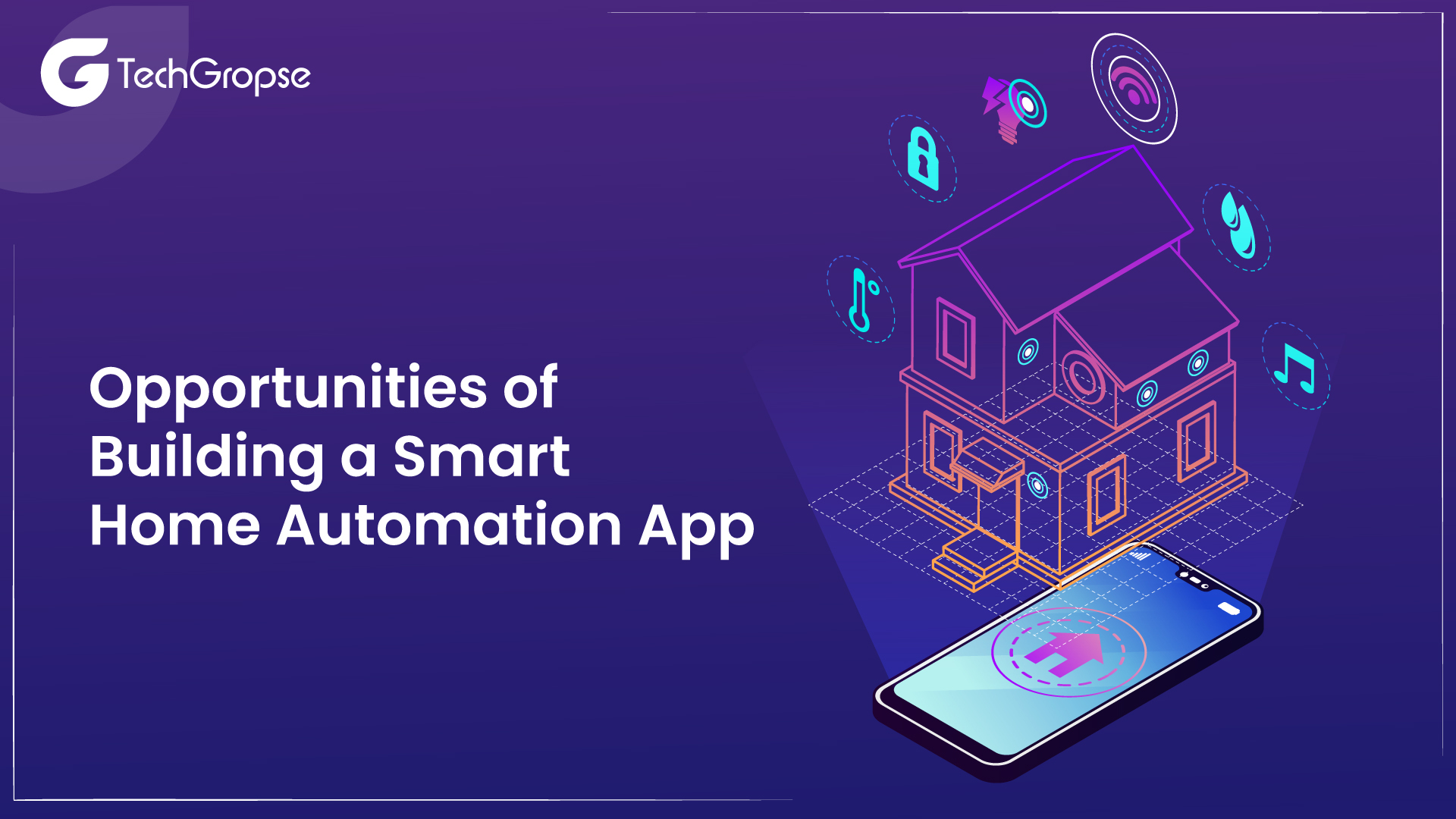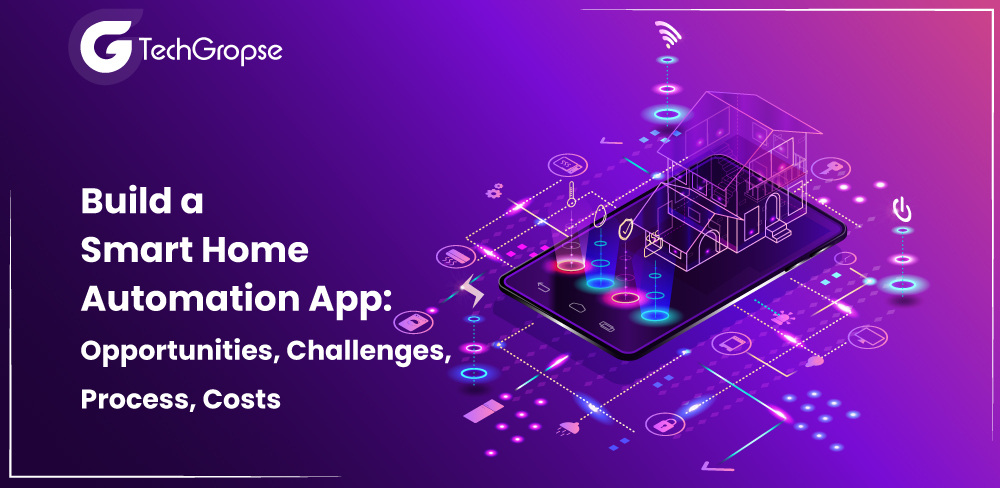The crime rates are increasing day to day. As a result, home security is the primary concern for house owners. There are lots of people who check several websites and newspapers to know about something that can make sure the security of their premises. As a result, smart home automation app development is a boon for those who are concerned about the security of their premises.
By using the smart home application, homeowners get an opportunity to remotely control various components of their houses, including security, temperature, lighting and entertainment systems. Generally, this app uses Internet of Things technology to connect devices for building a connected home environment.
Once anyone uses it, they can improve their quality of life by offering energy saving, automation and greater security through customizable user interface and cutting-edge features. In this blog post, we will share the information in detail about building a smart home automation app, opportunities, challenges and the cost associated with it. Without wasting your time, take a look at this post.
How Does Smart Home Automation Work?
You know that smart home automation uses a central hub directly connected to smart devices via wireless technology. This hub connects with gadgets like cameras, lights and thermostats through remote control from smartphone apps or voice commands.
The users are able to create a routine or schedule a few automated actions such as turning off the lights when they leave home. This hub can always be integrated with virtual assistance such as Alexa or Google Assistant for added control. The best thing about the app is that it increases convenience, security and energy efficiency by establishing a connected network that improves daily life and customizes the home environment.
Therefore, many agencies are deciding to build a smart home automation app that not only make sure security but also saves money in hiring a security person for your premises.
Opportunities of Building a Smart Home Automation App

No doubt that building a home automation app will offer lots of opportunities for both developers and users. Below we mentioned some opportunities associated with building a smart home automation app:
1. Enhanced Convenience
We all are aware that smart home automation gives users permission to control lots of aspects of their home such as temperature, lighting, security system and appliances through a single app. This convenience factor is a significant selling point for those users who are looking to sim lives and streamline their daily routine. Therefore, it is good to build a smart home automation app.
But building an app is not a cakewalk. In such a case, it is advisable to get in touch with a smart home automation app development company that has a good reputation and years of expertise in building an app.
2. Energy Efficiency
Another great opportunity to build a smart home automation app is energy efficiency. This application enables users to monitor and optimizee energy usage in their homes. By integrating with smart devices such as lighting systems, thermostats, and smart plugs, the application can assist users reduce energy consumption and lower utility bills. As a result, it is a great opportunity to build a smart home automation app.
If you want to build a smart home automation app, it is a good idea to search for a leading mobile app development company that has a team of experienced developers who are well-versed in building a functional app.
3. Increased Comfort and Personalization
A smart home automation application offers a personalized experience by learning user preferences and adapting the environment accordingly. For example, the application can adjust the temperature, music based on individual preferences, lighting and creating a more comfortable living space. As a result, it is a great opportunity to build a smart home automation app.
In order to make the development process easier and more efficient, you can seek the help of a mobile app development company that has years of experience. A leading development company never compromises on the quality. Therefore, it is good to seek the help of professionals.
4. Improved Security
Another great opportunity for building smart home automation apps is improved security. You know that this app often integrates with security systems that allow users to monitor their homes remotely and receive real-time alerts about potential security breaches. The users are able to control door locks, alarm systems, surveillance cameras, enhancing overall security and peace of mind.
However, you have to hire mobile app developers who are well-versed in building a functional and easy-to-use app. With good years of experience and knowledge they will do this job perfectly.
5. Integration With Other Smart Devices
The application can act as a central hub for controlling numerous smart devices and apps within the home. This integration opens up opportunities for developers to collaborate with other manufacturers as well as service providers to build a comprehensive smart home ecosystem.
Challenges With the Smart Home Automation App Development Process
We all are aware that a smart home automation app development process has several challenges. These challenges may affect the overall procedure. Below we mentioned some obstacles that you may face during smart home automation app development:
- Interoperability
One of the biggest challenges is ensuring interoperability with various smart devices and protocols. A smart home consists of different devices from different manufacturers, each with its own communication protocol. Developing apps that can work seamlessly across multiple devices and protocols requires extensive research and integration efforts.
- Device Fragmentation
The smart home market is highly fragmented with a large number of devices running on different platforms such as iOS, Android and various operating systems. Creating a consistent app experience across multiple platforms can be challenging, as developers must consider different design guidelines, hardware capabilities, and user expectations.
- Security and Privacy
Smart homes handle sensitive data such as personal information, device status, and user behaviour patterns. Ensuring the security and privacy of this data is extremely important. Developers should implement robust security measures such as strong authentication, data encryption, and protection against potential vulnerabilities and breaches.
- User Experience
A smart home automation app should provide a seamless and intuitive user experience. Users expect simplicity and ease of use when controlling smart devices. Designing a user-friendly interface, minimizing complexity, and providing clear instructions for device setup and configuration are important aspects of the development process.
- Tested and Compatible
Testing smart home automation apps can be challenging due to the variety of devices, operating systems, and network configurations. Developers should thoroughly test their apps on different platforms to ensure compatibility with different devices, firmware versions, and network environments. This process can be time-consuming and resource intensive.
- Scalability and Performance
As the number of connected devices and users increases, your app must meet scalability and performance requirements. For a smart home automation app to be successful, it’s important to ensure that your app can handle a large number of devices, provide real-time responses, and handle concurrent user requests without sacrificing performance.
Steps to Build a Smart Home Automation App
Once you know the opportunities and challenges you may face while building smart home automation, you have to start the development process. However, it involves several stages and procedures. Let’s explore the key step involved in smart home automation app development:
1. Dive Deep in the Market and Analyse the Data
The first step to build a smart home automation app, you have to dive deep into the market and analyse the data. This step involves understanding the target audience, preferences and identifying their requirements as well as evaluating the competition. Diving deep into the market you can get new ideas about the trend and analyze user feedback. It will assist you to build a smart home automation app.
In order to make the development process easier and more efficient you can seek the help of an on-demand app development company that helps you in every possible way. So, it is easier for you to build a smart home automation app.
2. Defining App Features
The next step to build a smart home automation app is defining app features. This includes determining the devices and systems that the application will integrate with such as lighting systems, thermostats, security cameras and entertainment systems. The application should provide a comprehensive range of features that align with the requirements and expectations of the target audience.
To make the procedure easier, you can hire dedicated developers who are well-versed in building a functional app. They also make sure customer satisfaction. This is why it is good to seek the help of professionals for the best solutions.
3. User Interface and Experience Design
Once you define the features, you have to keep an eye on the user interface and expertise. This stage generally involves creating wireframes and prototypes to visualize the application’s layout, interaction patterns and navigation flow. The primary goal is to offer users an intuitive and visually appealing interface that gives them permission to control and monitor their smart home devices without any hassle.
4. Development and Integration
After finalizing the design, you have to start the smart home automation development process. This procedure involves writing code, integrating the app with various devices & systems and developing the backend infrastructure. However, it is essential to make sure of seamless communication between the application and the connected devices. This will enable users to control and automate their homes effectively.
5. Test the Application
Now it is time to test the application. Testing makes sure of the application’s performance, reliability and security. It includes functional testing in order to verify that all features work as intended and compatibility testing to make sure the app works across different devices, platforms and security testing to identify and address any vulnerabilities. However, you have to contact Android app developers for hire to get the ultimate solutions.
6. Deploy and Launch the App
Once the application is tested, you have to launch the app on the Google play store and Apple Store. After launching the app, you have to make an effective marketing strategy should be in place to generate buzz and attract users to download and use the app.
7. Continuous Improvement and Updates
We all know that building a smart home automation app is an ongoing procedure. Once you launch your app, you have to continuously gather user feedback, release updates to address any issue or introduce new features. Regular maintenance and updates are crucial to keep the application up to date with the latest technology and make sure a seamless user experience.
Cost to Build a Smart Home Automation App
The costs associated with creating a smart home automation app vary depending on various factors such as feature complexity, development resources, and the platform the app is built on. Cost factors to consider are:
- Functional Complexity
The complexity and number of features you want to include in your smart home automation app have a direct impact on development costs. Basic features such as remote device control and task scheduling are cost-effective compared to advanced features such as voice control, location-based automation, and third-party device integration.
| Type of Mobile App | Average Mobile App Development Cost | Time Duration |
| Simple App | $10,000-$35,000 | 3-6 Months |
| Moderately Complex App | $40,000-$80,000 | 6-9 Months |
| Highly Complex App | $85,000-$1,00,000 | More than 9 Months |
- Platform and Device Compatibility
Select the platforms you want to support. B. iOS, Android, or both affect development costs. Additionally, if you want your app to be compatible with different devices and protocols (smart speakers, smart thermostats, lighting systems, etc.), additional development effort and costs are required.
- UI and UX Design
The complexity and quality of UI and UX design affect smart home automation app development cost. Achieving a well-designed and intuitive user interface that provides a seamless user experience typically requires more time and effort from designers and developers, increasing overall costs.
- Security and Privacy
Smart home automation apps process sensitive user data and control devices in the user’s home. Ensuring robust security measures, data encryption, and privacy compliance can increase development costs. Additional work may be required for tasks such as user authentication, secure data storage, and data transmission.
- Testing and Quality Assurance
Rigorous testing and quality assurance processes are essential to ensure a stable and reliable smart home automation app. Testing on different devices, platforms, and scenarios to identify and fix bugs can increase development costs.
- Maintenance and Updates
After initial development, ongoing maintenance, bug fixes, updates, and compatibility with new devices and platforms may be required. Incorporating these factors into your budget can help ensure the long-term success of your app.
- Development Team and Location
The composition of the development team and its location can affect costs. Hiring experienced developers, designers, and quality assurance professionals usually comes at a higher cost. Additionally, development speed may vary depending on the region or country where the team is based.
| Region | App Development Hourly Cost |
| Saudi Arabia | $40-$60 Per Hour |
| Western Europe | $70-$100 Per Hour |
| Australia | $65-$120 Per Hour |
| US | $50-$90 Per Hour |
| India | $20-$40 Per Hour |
This table will help you in understanding home automation app development cost. However, you have to keep in mind that it is just an idea, not a reality. If you want to know the overall cost you have to contact the professionals. With years of experience and knowledge, they will provide you ultimate solutions.
The Final Note
Building a smart home automation app presents numerous opportunities for businesses to provide enhanced convenience, energy efficiency, security, and well-being to users. However, it also comes with challenges such as device compatibility, security concerns, and technical complexities. By following a well-defined development process and considering factors like costs, businesses can create a successful smart home automation app that caters to the growing demand for connected living spaces.
FAQs
1. What opportunities does the market for smart home automation apps offer?
The market for smart home automation apps presents multiple opportunities for homeowners, including increased convenience, energy efficiency, improved security, and the ability to remotely control and monitor various home devices. Demand for smart home solutions is expected to increase as the Internet of Things (IoT) continues to grow.
2. What are the challenges in developing smart home automation apps?
Developing a smart home automation app can present challenges such as These include ensuring compatibility with different devices and protocols, integrating different technologies, managing data security and privacy, dealing with network connectivity issues, and providing a seamless user experience across different platforms. F3:
3. What is the general process of developing a smart home automation app?
The development process typically includes the following steps:
- Requirements gathering and analysis.
- User interface and user experience design.
- Backend development such as database integration and API creation.
- Integration with various smart home devices and protocols. testing and quality assurance.
- Provisioning in the app store.
- Ongoing maintenance and updates.
4. What is the estimated cost of developing a smart home automation app?
The cost depends on many factors such as app complexity, number of features, target platform (iOS, Android, etc.), development team fees, etc. Approximate prices for basic smart home automation apps can range from $60,000 to $120,000. However, it is important to consult a development agency or professional for a more accurate cost estimate based on your specific needs.










